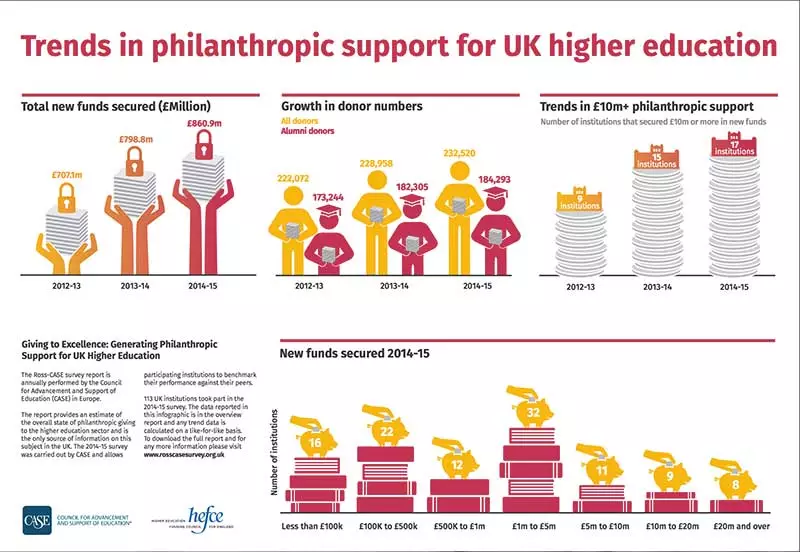Ross-CASE survey reveals 2014-15 rise in university philanthropic income
Income to higher education establishments showed a healthy increase in 2014-15, according to the 2016 Ross-CASE annual survey of charitable giving to universities.
Giving to Excellence: Generating Philanthropic Support for UK Higher Education covers 1st August 2014 – 31st July 2015 and uses cash income and new funds secured as the two main measures of reporting philanthropic income.
It reveals that income overall came fairly equally from individuals and organisations, with by far the greatest proportion of income from the latter coming from trusts and foundations.
Income
New funds increased by 8 per cent from 2013-14, reaching £860.9 million in 2014-15. 64 per cent of this income came from organisations (including companies, and trusts and foundations) and 36 per cent from individuals (including alumni donors). 191 donors gave gifts/pledges of more than £500,000 in 2014-15.
Total cash income received increased by 14 per cent from 2013-14 to £756.7 million in 2014-15. Total cash income from legacies reached £95.6 million in 2014-15 from 980 legacy donors. Individuals and organisations contributed 53 per cent and 47 per cent towards cash income respectively.
Donors
The total number of donors to universities was 232,520, with 98 per cent being individuals and 2 per cent organisations. Alumni donors accounted for 79 per cent of total donors. Total donor numbers showed a slight increase year-on-year (1.6 per cent), which the survey suggests is a shift towards a greater focus on donor value rather than number of donors giving.
Advertisement
Investment and costs
Total investment in alumni relations in 2014-15 was £39 million while total investment in fundraising was 2.5 times more at £93 million. Total fundraising costs increased by 10.5% along with alumni relations costs by 7%, highlighting continued investment in development and advancement operations across the UK Higher Education sector. Staff costs accounted for 71% of total fundraising costs and 67% of alumni relations costs. All costs include the costs of operational and administrative staff.
Division of income
Since 2013, the Ross-CASE Survey has used Latent Class Analysis methodology to identify groups of similar institutions. It has consistently found five clusters of reporting institutions with similar characteristics, called Elite, Established, Moderate, Emerging and Fragile.
The majority of the money goes to these established and elite institutions, with established institutes accounting for over 30 per cent of philanthropic income and number of donors in 2014-15 while Oxbridge accounts for 44 per cent of philanthropic income and 32 per cent of total donors. The remaining three clusters account for just over 20 per cent of philanthropic income and 31 per cent of donors.
Universities interested in participating in the next survey should eu****@ca**.org">contact the CASE Europe team for more information.





